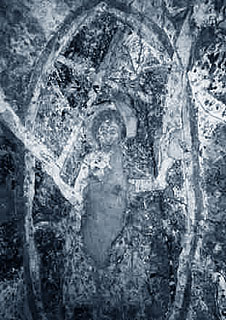
Edition 13 - May, 2003 |
Biofilms on murals: a habitat of novel bacterial
species
|
It is widely acknowledged that micro-organisms can be responsible for the
destruction of paintings. For this reason, restoration efforts do not always
achieve the expected result and sometimes even accelerate the deterioration
process. Ideally, restoration projects should thus include an inventory of
the micro-organisms associated with the damage of art. However, such data are
not obtained by simple diagnostic methods. To characterise bacteria reliably,
a polyphasic study, including genomic techniques, should be conducted. In the
past, most studies on biodeterioration have focused on understanding the deterioration
potential of the microbial community, so the characterisation of the bacterial
community associated with damage has often been unsatisfactory as it yielded
data that were not comparable with other studies. There was thus a clear
 |
need
for characterisation studies of a large group of isolates. Such a study was
performed at the Laboratory of Microbiology at Ghent University in Belgium
with material from 3 severely deteriorated mural painting sites: The necropolis
of Carmona in Spain with Roman mural paintings (1st-2nd century), the Chapel
of Saint Catherine in Herberstein Castle in Austria with medieval mural paintings
(14th century) and the Church of Greene-Kreiensen in Germany with late renaissance
mural paintings (16th century). Eleven samples were taken to study the bacterial
community and 429 strains were isolated. These isolates were studied by fatty
acid methyl ester (FAME) gas chromatography (1). The identification of the
main clusters at the generic level (Bacillus, Paenibacillus, Micrococcus
and Arthrobacter) was in accordance with previous studies. However, in general,
FAME analysis did not result in clear-cut identifications at the species
level
and 46 representative strains were chosen for further characterisation by
16S rDNA sequencing (2). Almost half of the sequences showed less than 97%
similarity
with the species in the EMBL, thus excluding their allocation to any of the
species covered. 16S rDNA sequencing identified the majority of the strains
at the genus level as belonging to Bacillus and related genera (Paenibacillus,
Virgibacillus), Arthrobacter, Brachybacterium, Brevibacterium, Halomonas,
Methylobacterium, Micrococcus, Nocardioides, Sphingomonas, Staphylococcus and
Streptomyces. Additional
isolates were further studied by rep-PCR genomic fingerprinting, partial
16S rDNA sequencing and DNA:DNA reassociation experiments. The results of this
study demonstrated the existence of novel genospecies and further chemotaxonomic
and phenotypic analysis allowed description of seven novel species: Brachybacterium
sacelli and Brachybacterium fresconis (3), Halomonas muralis (4), Bacillus
decolorationis (5), and Virgibacillus carmonensis, Virgibacillus necropolis
and Virgibacillus picturae (6). Type strains and additional representative
strains are deposited at the BCCM™/LMG Bacteria Collection. The finding
and description of novel bacterial species associated with damage on mural
paintings is clear evidence that research on biodeterioration of art needs
the input of taxonomists in order to improve treatment of these art objects.
1. J. Heyrman et al., FEMS Microbiol. Lett. 181, 55-62 (1999)
2. J. Heyrman, J. Swings, Syst. Appl. Microbiol. 24, 417-422 (2001)
3. J. Heyrman et al., Int. J. Syst. Evol. Microbiol. 52, 1641-1646 (2002)
4. J. Heyrman et al., Int. J. Syst. Evol. Microbiol. 52, 2049-2054 (2002)
5. J. Heyrman et al., Int. J. Syst. Evol. Microbiol. 53, 459-463 (2003)
6. J. Heyrman et al., Int. J. Syst. Evol. Microbiol. 53, 501-511 (2003)
Contact
Jeroen Heyrman
Laboratory of Microbiology
Ghent University
K.L. Ledeganckstraat 35, B-9000 Gent
E-mail: jeroen.heyrman@rug.ac.be


